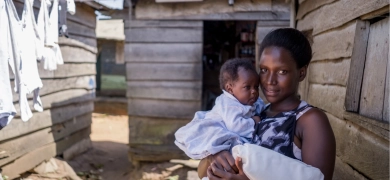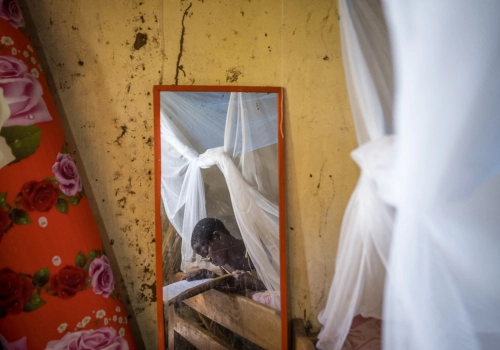A billion nets and counting
How textile innovation transformed malaria prevention

20 September 2023
Category:
Innovations in disease controlWhat does a billion look like?
For us, it looks like a net—one billion of them, in fact. Each one a small but powerful tool in the fight against malaria. From a modest textile factory in Denmark to a global health partner, our journey has been anything but ordinary. This is the story of how innovation, purpose, and partnership came together to help save millions of lives.
From workwear to global health: A company’s transformation
In 2023, our billionth net rolled off the production line—a milestone that prompted reflection on our journey from a small, Danish family-owned textile company to a global health partner.
Mikkel Vestergaard Frandsen joined the company in the early 1990s, when it was still focused on uniform production in Denmark. His experience living and working in Nigeria from the age of 19 profoundly shaped his understanding of the complex factors influencing health outcomes—limited access to care, overlapping disease burdens, and broader social and economic challenges. This experience ignited a determination to apply his family’s textile expertise to public health.
Since the late 1990s, Mikkel has led the company’s transformation into a social enterprise dedicated to improving lives—a mission rooted in what he calls “humanitarian entrepreneurship.” Under his leadership, the company shifted its focus to products with a humanitarian purpose, marking a pivotal turning point.
Engineering innovation: How a net became a lifesaver
This new direction led us to apply our material science and textile engineering capabilities to global health challenges—most notably, malaria. At the time, insecticide-treated nets had proven effective in preventing the disease, but scaling production and improving durability remained significant obstacles.
In response, we developed PermaNet, a long-lasting insecticidal net (LLIN) that embedded insecticide directly into the fibers. This innovation ensured effectiveness even after multiple washes and years of use, accelerating global LLIN distribution and transforming malaria prevention in resource-limited settings.
LLINs have since become a cornerstone of malaria control, saving countless lives and significantly improving health outcomes. Their impact underscores the power of practical innovation in global health.

Reflecting on the billionth net, Mikkel shared:
“Malaria is utterly preventable. Because we have the technology, it is just a matter of will to ensure that nobody dies.
When I began building this business in 2000, 1.3 million people—mainly children—were dying each year. Last year, that number was 627,000. While the mortality rate has halved, too many are still dying.
So yes, a billion is a significant number. It shows what we can achieve when we work together. I hope we see this as just a prologue to the great work still to come. The responsibility now lies with partners to carry the goal of elimination across the finish line.”
The road ahead: Innovation, partnerships, and the next billion nets
LLINs remain central to national malaria control strategies, and our PermaNet products continue to play a vital role. Between 2000 and 2015, LLINs were responsible for preventing 68% of malaria cases averted in Africa, helping save over 11.7 million lives.
We continue to invest in our LLIN portfolio, prioritizing quality, data, and rigorous field testing. Our progress has been driven by strong partnerships and sustained collaboration with public and private sector stakeholders, including governments and academic institutions.
As Mikkel once said, “We are like one wheel in the fight against malaria—essential, but all the parts need to work together.” That spirit of shared responsibility continues to guide our work.
Today, the fight against malaria faces new challenges—from insecticide resistance to funding constraints—making the need for effective, scalable tools more urgent than ever. Our story, from a family-run textile business to a key player in global malaria efforts, illustrates a broader truth: innovation doesn’t always begin in a lab. Sometimes, it starts on a factory floor—with a simple decision to do more.
“While the one billionth net is cause for celebration, it’s also a moment to reflect on the turning points that made malaria prevention one of the most consequential public health campaigns of the past 25 years.
This milestone honours the pioneers, partners, and champions—whether through the development and scaling of LLINs, the integration of child health programs, the rise of mega-donors, or the power of goal-oriented advocacy and collaboration.
My appreciation is immense for the role you’ve played in this impactful journey. The fight against malaria would not have been nearly as effective without our many valued partners.”